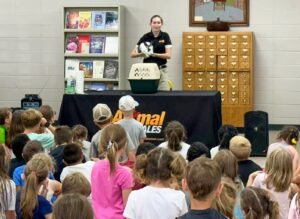Ice cream: Make your summer outing cool, safe
By Staff
July 11, 2004
I'm sure many of you have been enjoying all the church socials, family reunions, picnics and other outings that go along with summertime.
Usually someone brings along some homemade ice cream to complete the meal. There is nothing better than a dish of smooth homemade ice cream as long as it has been prepared correctly.
If your favorite ice cream recipes use uncooked eggs, it's time to think about replacing or revising them. Those raw eggs may contain salmonella bacteria that can cause food-borne illness. Freezing doesn't kill the bacteria, but cooking does.
What's the danger
in ice cream?
Since thorough cooking is necessary to destroy the salmonella bacteria, foods that contain raw or lightly cooked eggs such as ice cream are risky and should be avoided.
Eggs are used in ice cream to add a rich flavor and color, inhibit ice crystallization and help stabilize or emulsify the fat and liquid so the resulting product is smooth and creamy.
Although salmonella bacteria will not grow below 40 degrees, freezing does not destroy organisms already present in the raw egg. Only recipes that call for cooking the egg mixture are safe to use. These are sometimes referred to as cooked custard ice cream.
Another option is to use pasteurized eggs in recipes that call for raw eggs. Commercial pasteurization destroys salmonella bacteria, but does not cook the eggs or affect their color, flavor, nutritional value or functional properties.
Whole liquid pasteurized eggs are available at some supermarkets. They are packaged in containers that resemble a small milk carton and are in the refrigerator case. Use them just as you would fresh, whole eggs.
Light ice creams that use no eggs or have gelatin added are good choices for those concerned about cholesterol.
Vanilla Ice Cream
The basic cooked custard recipe makes about one gallon in a standard ice cream freezer.
2 cups sugar
1⁄4 cup cornstarch
1⁄4 teaspoon salt
4 cups milk
4 eggs, beaten
2 tablespoons vanilla
4 cups light cream
Mix sugar, cornstarch and salt in the top of a double boiler. Gradually blend 4 cups milk. Cook over hot water, stirring occasionally until thickened, 12 to 15 minutes. Stir a small amount of the hot cornstarch mixture into the beaten eggs, and then stir the eggs into the remaining cornstarch mixture.
Continue cooking, stirring constantly 4 to 5 minutes longer or until the mixture is about the consistency of pudding; chill thoroughly. This step is essential for a smooth ice cream.
Stir in vanilla and remaining milk or cream. Pour into a 1-gallon ice cream freezer and freeze according to the manufacturer's directions.
Remove dasher, replace lid and plug; add mixture of ice and salt to freezer, if needed, cover with heavy blanket and allow ice cream to harden about 2 hours.
Fruit variation: Stir in 2 cups crushed or pureed fruit after removing dasher.
Chocolate swirl variation: Swirl 2 cups chocolate sauce through ice cream after removing dasher.
Strawberry Ice Cream
This recipe, when compared to a full fat, full sugar version, has a 45 percent reduction in calories, a 50 percent reduction in fat, a 38 percent reduction in carbohydrates and a 50 percent reduction in sugars. This recipe is provided by Splenda.
12 ounces evaporated milk
1 cup heavy cream
3⁄4 cup whole milk
1⁄2 cup instant nonfat dry milk
2 tablespoon honey
3⁄4 cup Splenda granular
1⁄2 cup cold water
1 teaspoon unflavored gelatin
2 tablespoons cornstarch
2 cups crushed fresh strawberries
Make ice cream base. Whisk together the evaporated milk, cream, whole milk, nonfat dry milk, honey and Splenda Granular in a large mixing bowl. Stir well and set aside.
Stir in gelatin and cornstarch together in a microwaveable bowl. Pour cold water into the gelatin and cornstarch mixture. Stir well using a small whisk, until the mixture is very well blended and there are no visible lumps.
Microwave gelatin mixture on high about 2 minutes, stopping and stirring every 30 seconds, or until a thick clear gel forms. (If the gel turns into one big lump, simply start over. It means that your microwave could have been too hot or you were not stopping and stirring the mixture frequently enough.)
Remove cooked mixture from microwave. Slowly add 3⁄4 cup of the ice cream base into the gelatin. Stir well, making sure the gelatin and cornstarch are evenly distributed and there are no visible lumps.
Pour back into remaining ice cream base and mix well. Add crushed strawberries and stir until just blended.
Freeze in ice cream maker following manufacturer's instructions. Best if eaten right away!
Hopefully, you will have fun sharing these recipes with friends. If you would like more information on making ice cream, please call the Lauderdale County Extension Office at 482-9764.










